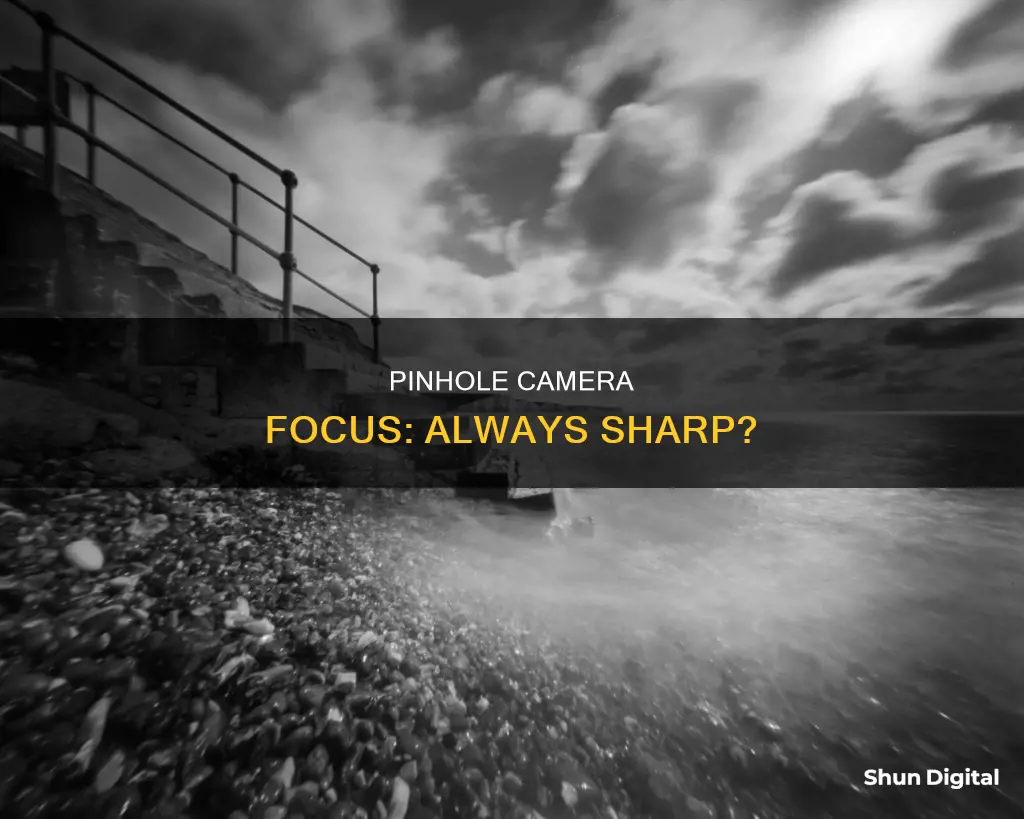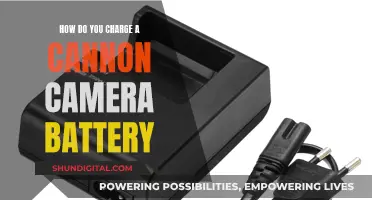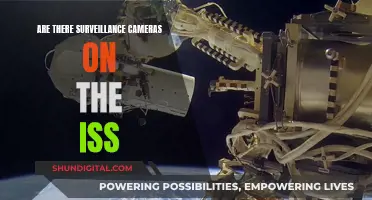
Pinhole cameras are optical devices that capture images without the use of lenses. They work by allowing light to pass through a tiny aperture, creating a clear image on the image plane. The concept of focus in pinhole cameras differs from traditional lens-based cameras. Due to their small aperture, pinhole cameras have an extremely wide depth of field, resulting in a nearly infinite focus range. This means that objects at various distances from the camera can be captured in focus simultaneously. However, the trade-off is that pinhole cameras require longer exposure times to capture sufficient light, and any movement during the exposure will result in blur.
| Characteristics | Values |
|---|---|
| Need for focus | No |
| Reason for lack of need for focus | Nearly infinite depth of field due to tiny aperture |
| Effect of tiny aperture | Only one place where light from an object can fall on the image plane |
| Drawback of pinhole camera | Long exposure time |
| Optimal pinhole size range | 0.2-1.00 mm |
What You'll Learn

Pinhole cameras have a nearly infinite depth of field
The concept of focus in a pinhole camera is different from that of a traditional camera with a lens. In a pinhole camera, the tiny aperture allows only a small amount of light to pass through, creating an inverted image on the opposite side of the box. This image is formed by countless circles of confusion, which are projected onto the film or image sensor by the pinhole. These circles are created by the overlap of light rays passing through the pinhole, and their size determines the perceived sharpness of the image. If the circles are too large, the observer will see disks and perceive the image as fuzzy. However, if the circles are small enough, the image will appear sharp and in focus.
The size of the pinhole is critical to achieving a sharp image. If the pinhole is too small, interference and diffraction effects can cause image blur. Additionally, a very small pinhole will result in longer exposure times as less light passes through. On the other hand, if the pinhole is too large, the image will also be blurry due to the overlap of light rays. Therefore, an optimal pinhole size must be chosen to balance sharpness and exposure time.
The depth of field in a pinhole camera is theoretically infinite, meaning that all objects at different distances from the camera can be in focus simultaneously. This is in contrast to traditional cameras with lenses, where the focus must be adjusted to ensure that the desired object is sharp. The infinite depth of field in pinhole cameras provides a unique creative opportunity for photographers, allowing them to capture images with a dreamlike appearance and unlimited depth of field.
Dodge Charger GT: Reverse Camera Availability
You may want to see also

The tiny aperture of a pinhole camera filters out unwanted light rays
Pinhole cameras are the simplest type of camera possible. They are typically made from a light-proof box, some sort of film, and a pinhole. The pinhole is a tiny hole that acts as the camera's aperture. The aperture controls the amount of light entering the camera and reaching the image plane.
The pinhole aperture in a pinhole camera filters out unwanted light rays. The tiny hole only allows specific light rays from the scene to pass through, creating a clear image. This is because each point of light in a scene emits light, and the beam of light from that point passes through the pinhole, creating a point of light on the image plane. All of the points in the scene do this simultaneously, resulting in a complete, focused image.
The size of the pinhole aperture is important. Smaller pinholes create sharper images because the projected circle of confusion at the image plane is roughly the same size as the pinhole. However, extremely small holes can cause diffraction effects, resulting in a less clear image. Vignetting can also occur if the diameter of the hole is similar to the thickness of the material it is punched into. Therefore, the best pinhole is perfectly round and thin.
The distance between the pinhole and the image plane also affects the image. Moving the image plane closer to the pinhole will result in a wide-angle field of view and shorter exposure time. Moving it further away will result in a telephoto or narrow-angle view and longer exposure time.
Automatically Numbering in Camera Raw: A Step-by-Step Guide
You may want to see also

Pinhole cameras do not need to focus
The size of the images produced by a pinhole camera depends on the distance between the object being photographed and the pinhole. The smaller the hole, the sharper the image, but the dimmer the projected image. The optimal size of the aperture should be 1/100 or less of the distance between it and the projected image.
The depth of field in a pinhole camera is theoretically infinite. There is a formula to determine the optimum pinhole size for any given focal length, which is the distance between the pinhole and the film. In practice, the hole size should be small enough to give good sharpness but large enough not to produce diffraction effects.
Pinhole cameras use long exposures to capture an image, and any movement captured in the photo will be seen as a blur.
Traffic Camera Tickets: Legal in Newburgh Heights, Ohio?
You may want to see also

A pinhole camera uses long exposures to capture an image
A pinhole camera is a simple camera without a lens, but with a tiny aperture, that can capture images using long exposures. The pinhole is an extremely small hole, often compared to the size of a hole made by a pin in a piece of thick aluminium foil. This aperture is used to control the amount of light entering the camera, acting as a lens to filter out unwanted light rays and form an inverted image on the image plane.
The pinhole camera is an example of the camera obscura effect, a natural optical phenomenon. The image of the scene is projected onto the opposite side of the box, with the size of the image depending on the distance between the object and the pinhole. The smaller the pinhole, the sharper the image, but also the dimmer the projected image.
The use of a pinhole camera removes the need for a lens, as the pinhole forces every point emitting light in the scene to form a small point on the film, resulting in a crisp image. However, due to the small size of the pinhole, the camera requires long exposure times to capture an image, as only a small amount of light can pass through the pinhole.
The first known description of pinhole photography was found in Scottish inventor David Brewster's 1856 book, 'The Stereoscope', which described the idea as "a camera without lenses, and with only a pin-hole". Pinhole cameras have since been used for artistic purposes, as well as for educational purposes, allowing people to learn about and experiment with the basics of photography.
Fine-Tuning Your Axis M3037: Focus Adjustment Techniques
You may want to see also

The size of the pinhole is key to capturing a sharp image
Pinhole cameras are simple cameras without a lens, but with a tiny aperture, effectively a light-proof box with a small hole in one side. The size of the pinhole aperture is key to capturing a sharp image.
Firstly, it is important to understand how a pinhole camera forms an image. Light from a scene passes through the pinhole and projects an inverted image on the opposite side of the box, known as the camera obscura effect. The size of the image depends on the distance between the object and the pinhole. Each point of light from the scene is projected as a circle onto the image plane, and the amount of blurring is reduced as the circle size decreases, resulting in a sharper image. Therefore, a smaller pinhole will generally produce a sharper image.
However, when light passes close to an edge, it is bent by that edge due to diffraction. This effect is minimal for a large hole, as the area away from the edge is significantly larger than the area near the edge that is subject to diffraction. As the hole size decreases, a point is reached where the image begins to blur again due to diffraction. Thus, there is a transition point where the hole is of an optimal size, balancing the geometric blurring of a large hole with the diffraction blurring of a small hole to produce the sharpest image.
The optimal pinhole size has been the subject of much scientific investigation, with various scientists, including Prof. Joseph Petzval, Lord Rayleigh, and Prof. Lommel, proposing different equations to calculate the ideal pinhole diameter based on factors such as focal length and the wavelength of light. While there may not be a definitive "best" pinhole size, certain sizes are useful for achieving different results, such as sharper foreground or background focus.
In addition, the distance between the film and the pinhole can also impact the sharpness of the image. Moving the film closer to the pinhole results in a wider field of view and shorter exposure time, while moving it farther away creates a telephoto or narrow-angle view and longer exposure time.
Bayit Outdoor Camera: Is It Battery-Powered?
You may want to see also
Frequently asked questions
A pinhole camera is a simple camera without a lens that uses a tiny aperture (hole) to control the amount of light entering the camera and form an image on the image plane.
The small aperture of a pinhole camera allows only specific light rays from the scene to pass through, creating a clear image. Since the aperture is very small, the camera has a wide depth of field, allowing everything in the scene to be in focus.
Regular cameras use lenses to focus light and capture images. Pinhole cameras, on the other hand, rely solely on the small aperture to capture images, resulting in a longer exposure time and a lower amount of light entering the camera.
Pinhole cameras offer an extremely wide depth of field, meaning that objects at different distances from the camera can all be in focus at the same time. This eliminates the need for focusing the camera.
Yes, due to the small aperture, pinhole cameras require longer exposure times to capture images, and any movement during the exposure will result in blur in the photograph. Additionally, the small aperture limits the amount of light entering the camera, resulting in darker images.







